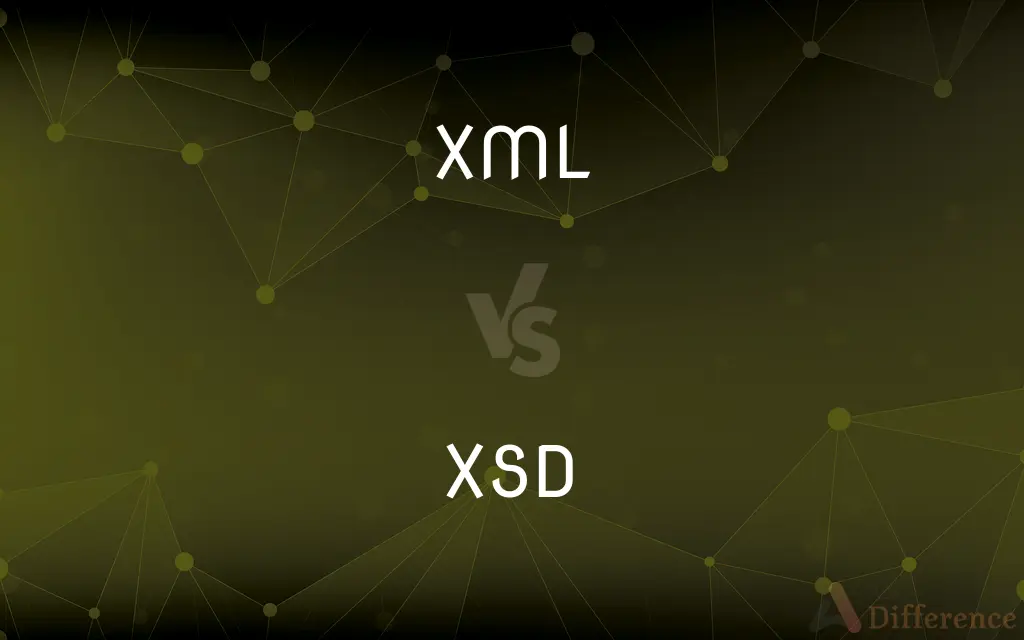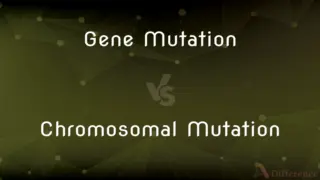XML vs. XSD — What's the Difference?
By Tayyaba Rehman — Published on November 16, 2023
XML stands for eXtensible Markup Language, which defines a set of rules for encoding documents, while XSD (XML Schema Definition) provides a way to describe and validate the structure of XML data.

Difference Between XML and XSD
Table of Contents
ADVERTISEMENT
Key Differences
XML, which stands for eXtensible Markup Language, is a versatile markup language that allows you to define your tags. It is used to encode data in a format that is both human-readable and machine-readable. XSD, on the other hand, stands for XML Schema Definition and serves as a blueprint for what an XML document can contain.
Within the world of data representation, XML provides a flexible way to structure data, with no predefined tags, allowing users to define their elements. XSD, in contrast, offers a framework that dictates how an XML document should be structured. It defines the elements, attributes, ordering, and data types that an XML can have.
Think of XML as the narrative or the story, with its characters and events, while XSD is the grammar rulebook that ensures the story flows logically and makes sense. Every time XML lays out a scene or introduces a character, it refers back to XSD to make sure it's following the guidelines.
From a practical viewpoint, when a software system needs to interchange data, XML acts as the intermediary format, ensuring data consistency. XSD plays a critical role in ensuring this consistency by laying down the rules which the XML document must adhere to, ensuring data integrity.
Lastly, while XML focuses on data representation, showcasing what the data is, XSD emphasizes data validation, ensuring the data is presented in the correct manner and structure, adhering to predefined standards and guidelines.
ADVERTISEMENT
Comparison Chart
Definition
Markup language for encoding data.
Schema to describe XML structure.
Purpose
Data representation.
Data validation and structure definition.
Flexibility
Allows defining custom tags.
Defines strict rules for XML content.
Role
Narrative/Data.
Rulebook/Validator.
Associated Action
Encodes information.
Validates XML structure.
Compare with Definitions
XML
XML ensures both human and machine readability.
Developers can easily read and understand XML documents.
XSD
XSD establishes relationships between XML elements.
XSD can mandate that the tag must have child elements like and .
XML
XML serves as an intermediary for data interchange.
XML files can be used to transfer data between heterogeneous systems.
XSD
XSD enables data validation for XML.
With XSD, you can verify if the XML document follows the correct structure.
XML
XML allows custom tag definition.
In XML, you can define tags like John for data representation.
XSD
XSD provides rules for XML document structure.
XSD ensures that an XML for user data has the necessary fields like name and age.
XML
XML is platform-independent.
XML data can be processed by any platform or system.
XSD
XSD defines the elements and attributes of XML.
An XSD can specify that the tag in XML should contain integer values only.
XML
XML is a markup language to encode information.
XML is widely used in web services to exchange data.
XSD
XSD dictates the data types in XML.
XSD can ensure that a tag in XML contains decimal values.
XML
An international standard metalanguage for creating markup languages that structure digital information in a way that allows for the exchange, display, and storage of data independent of proprietary operating systems and hardware devices.
Common Curiosities
Why is XSD important in the XML context?
XSD defines and validates the structure of an XML document.
Does every XML file require a corresponding XSD?
No, but having an XSD helps in validating the XML's structure and data.
How is XML different from HTML?
While both are markup languages, XML defines data structure, while HTML displays data.
Can XSD dictate data types in XML?
Yes, XSD can specify data types for XML elements and attributes.
What software can I use to validate XML against XSD?
Tools like XMLSpy, oXygen, and even online validators can validate XML using XSD.
Is XML platform-dependent?
No, XML is platform-independent and can be used across different systems.
What does XML stand for?
XML stands for eXtensible Markup Language.
Is XML case-sensitive?
Yes, XML is case-sensitive, meaning and are treated differently.
Are XML and XSD used only for web services?
No, while commonly used in web services, they have various applications like configuration files, data storage, and more.
Can XSD have default values for XML elements?
Yes, XSD can specify default values for XML elements if they are not provided.
Can I use XML without XSD?
Yes, XML can be used without XSD, but XSD provides structure validation.
How does XSD help in data interchange?
XSD ensures that XML documents exchanged between systems adhere to a consistent structure.
How does XSD ensure data integrity in XML?
XSD defines the structure, data types, and relationships, ensuring XML data is correctly formatted.
Can one XSD be used for multiple XML files?
Yes, a single XSD can validate multiple XML files with similar structures.
Can I define my custom tags in XML?
Yes, XML allows users to define custom tags for data representation.
Share Your Discovery

Previous Comparison
Gene Mutation vs. Chromosomal Mutation
Next Comparison
Capital Lease vs. Operating LeaseAuthor Spotlight
Written by
Tayyaba RehmanTayyaba Rehman is a distinguished writer, currently serving as a primary contributor to askdifference.com. As a researcher in semantics and etymology, Tayyaba's passion for the complexity of languages and their distinctions has found a perfect home on the platform. Tayyaba delves into the intricacies of language, distinguishing between commonly confused words and phrases, thereby providing clarity for readers worldwide.
















































